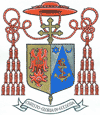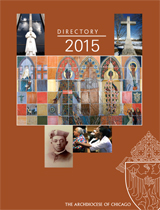
The Cardinal’s Column
Francis Cardinal George, O.M.I.
July 20, 2008
Mary Immaculate in Chicago and Lourdes
Cardinal George's Schedule
- July 20-23: Christchurch, New Zealand
- July 24: 10 a.m., Episcopal Council Meeting, Residence
- July 26: 4:30 p.m., 125th Anniversary Mass, Maryville Academy, Des Plaines
- July 27: 10:30 a.m., Mass and Tabernacle Blessing, St Joseph, Summit
- July 29: Presentation at Fides Et Ratio Seminar, University of Notre Dame, South Bend, Ind.
- July 30-31: Mass of Dedication, Church of the Shrine of Our Lady of Guadalupe, La Crosse, Wis.
- Aug. 1: 1:30 p.m., College of Consultors, Pastoral Center; 7:30 p.m., Lourdes Pilgrimage Departure Mass, Queen of All Saints Basilica

Cardinal's Appointments
Vicariate IV has been re-divided into five Deaneries from three Deaneries. Two new Deaneries were created, and Cardinal George has appointed deans for their care.
Rev. Jeffrey Grob, pastor of St. Celestine Church, Elmwood Park, has been appointed Dean of Deanery IV-D in the northwest side of the Vicariate.
Rev. Robert Clark, Pastor of St. Cletus Church, La Grange, is the new dean of Deanery IV-E in the southwest side of Vicariate IV.
The doctrine that Mary of Nazareth was without sin from the first moment of her conception in the womb of St. Ann was officially defined by Pope Pius IX in 1854. Four years later, in 1858, Mary appeared in Lourdes, France, to St. Bernadette Soubirous.
In the course of 18 apparitions over a five-month period, Mary told the young girl: “I am the Immaculate Conception.” The words made no sense to Bernadette, but she repeated them over and over to herself in order to tell them to her parish priest, who knew she could not have made them up. The Blessed Virgin also told Bernadette: “I do not promise you happiness in this world, but in the next,” and she instructed Bernadette to “tell the priests that people should come here in procession.” In a letter written to Father Ferdinand Gontrand, O.M.I., Bernadette put into writing for the first time, in 1860, what had happened two years before. It is that report which one reads in the Liturgy of the Hours for the feast of Our Lady of Lourdes on Feb. 11.
In 2008, on the 150th anniversary of the apparitions, the Archdiocese of Chicago will make an official pilgrimage to pray at Mary’s shrine in Lourdes. Chicago’s history with Mary Immaculate began long before the declaration of the dogma. Drawing on the teachings of major Church Fathers from the early centuries of Christianity and relying on theological reflection over the ages and the development of popular piety, many bishops encouraged their people to pray to Mary Immaculate. One such bishop was William Quarter, the first bishop of Chicago, who dedicated the new diocese in 1843 to the “Immaculate Mother of God.”
Bishop Quarter may or may not have been aware of a similar dedication made in 1674 by Jesuit Father Jacques Marquette when he passed the winter on the southern shore of Lake Michigan, which he called “the Lake of the Illinois.” On Dec. 4, 1674, Marquette and his companions arrived at the Chicago River after a torturous six-week journey from DePere, Wis. He preached to the Pottawatomie natives and intended to go on to the Illinois tribes when he fell ill with severe stomach and digestive pains.
In his journal, Marquette noted that he said Mass almost every day, but was “unable to celebrate Holy Mass on the day of the Conception (Dec. 8), owing to the bad weather and cold.” His diary entry for Dec. 15 recorded: “We said the Mass of the Conception. After the 14th, my disease turned into a bloody flux.” On Feb. 9, 1675, he began a novena to Mary Immaculate to gain the strength he needed to visit the Illinois Indians and then return to St. Ignace, the Jesuit headquarters at the other end of Lake Michigan. He preached to the natives at Kaskaskia and dedicated the mission there and the Mississippi river itself to “the Immaculate Conception of the Blessed Virgin.”
At the end of the winter, on March 30, 1675, he wrote: “The Blessed Virgin Immaculate has taken such care of us during our wintering that we have not lacked provisions, and have still remaining a large sack of corn, with some meat and fat. We also lived very pleasantly, for my illness did not prevent me from saying Holy Mass every day. We were unable to keep Lent, except on Fridays and Saturdays.” During the journey in April along the eastern shore of Lake Michigan back to St. Ignace, Marquette died on May 18, 1675, near what is now Ludington, Mich. He was 38 and had been a Jesuit for 21 of those years.
His Jesuit Superior, Father Dablon, wrote of him: He was “a Frenchman with the French, a Huron with the Hurons, an Algonquin with the Algonquins…But that which apparently predominated was a devotion, altogether rare and singular, to the Blessed Virgin, and particularly toward the mystery of her Immaculate Conception. All his conversations and letters contained something about the Blessed Virgin Immaculate — for so he always called her. So tender a devotion toward the Mother of God merited some singular grace; and she accorded him the favor that he had always requested — to die on a Saturday. His companions never doubted that she appeared to him at the hour of his death, when, after pronouncing the names of Jesus and Mary, he suddenly raised his eyes above his crucifix, holding them fixed on an object which he regarded with extreme pleasure and a joy that showed itself upon his features; and they had at that time, the impression that he had rendered up his soul into the hands of his good mother.”
The archdiocesan pilgrimage to Lourdes will take place in the first week of August. Following the example of the first missionary here and the first bishop of Chicago, we will be praying to Mary Immaculate for personal needs and the needs of the Church and the world. Lourdes is a city of the sick, with everything designed to make it possible for them to visit, take the baths and pray. Pilgrims who could not otherwise afford the trip are being helped by generous people who are making it possible for those of all economic classes and degrees of health to be part of the pilgrimage. We will bring Chicago to Lourdes, while Chicagoans here, led by Bishop Thomas Paprocki and priests of the archdiocese, will be participating in special Masses and processions, many of them in parishes named in honor of Our Lady of Lourdes or at grottoes built on parish grounds.
What will we pray for at Lourdes? For healing. For the healing of the lives of those who have been sexually abused and for the healing of the wound to the church that such abuse has inflicted. For the healing of animosities among Catholics and of hatred toward our religion. For the healing of families, many of them torn apart by divorce and abandonment, by deportation of fathers or mothers, by seemingly irreconcilable differences between spouses and by economic pressures. For the healing of divisions among Christians and between races and cultures. For the healing of wounds inflicted by warfare and civil conflict. For the healing of bodies and souls, the healing of our brokenness through the forgiveness of our sins. It is an archdiocesan pilgrimage, and we will pray for Chicago.
I invite everyone to join us in that prayer. God bless you.
Sincerely yours in Christ,
Francis Cardinal George, OMI
Archbishop of Chicago
 Catholic
New World - Newspaper for the Archdiocese of Chicago
Catholic
New World - Newspaper for the Archdiocese of Chicago Archdiocese of Chicago Directory
Archdiocese of Chicago Directory Oficjalne wydawnictwo Archidiecezji Chicago w języku polskim
Oficjalne wydawnictwo Archidiecezji Chicago w języku polskim